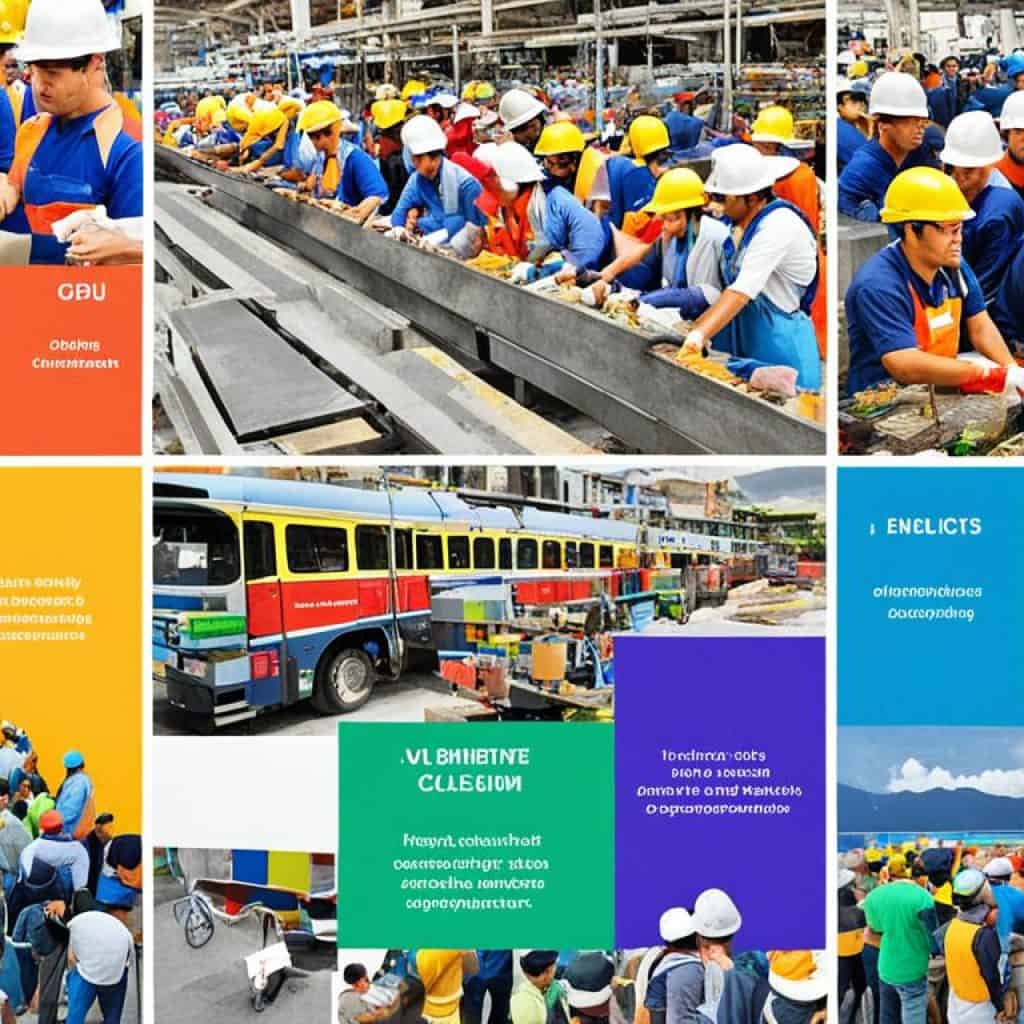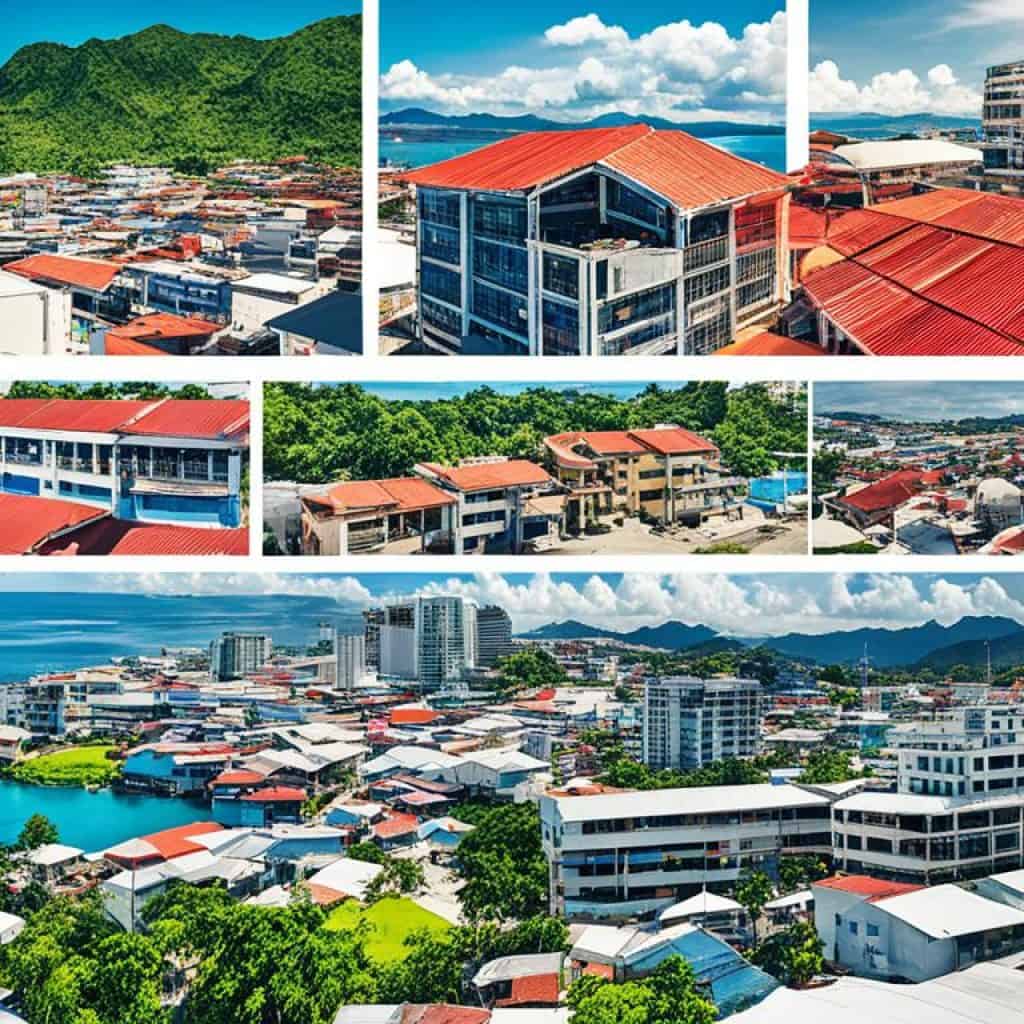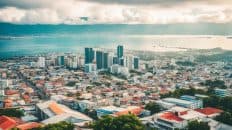Did you know that Cebu, in the Philippines, is not only a vibrant region but also one of the largest cities globally with a significant consumer market? The population of Cebu is experiencing rapid growth, making it an attractive destination for businesses looking to tap into a thriving consumer base.
Evaluating key indicators across various sectors, such as population, consumer expenditure, digital consumer behavior, and more, Euromonitor’s City Scorecard provides valuable insights into the market potential and consumer attractiveness of Cebu. This comprehensive evaluation helps businesses gain a deeper understanding of the city’s potential and tailor their strategies accordingly.
Key Takeaways:
- Cebu is one of the largest cities globally with a significant consumer market
- The population of Cebu is experiencing rapid growth
- Euromonitor’s City Scorecard evaluates key indicators to understand market potential
- Businesses can tailor their strategies based on demographic insights
- Cebu offers a thriving consumer base for businesses to tap into
Cebu’s Population Growth and Comparison to Other Cities in the Philippines
Cebu City, with a population of 799,763, is the second-largest growth area in the Philippines after Manila. However, when considering the entire Metro Cebu, which includes other cities like Lapu-Lapu, Mandaue, and Talisay, the population reaches around 2 million. This significant population size positions Cebu as a key player in the country’s demographic landscape.
Strategically located and easily accessible by air and water, Cebu City plays a crucial role in regional trade and transportation. Its status as an important port in the region further strengthens its position as a hub for economic activities.
In the coming years, Cebu City’s population is expected to experience further growth. This growth promises to contribute to the city’s economic development and presents lucrative opportunities for businesses seeking to establish a presence in this dynamic market.
“Cebu’s population growth and bustling economic activity make it a vibrant city with immense potential for businesses looking to expand their reach in the Philippines.”
To gain a deeper understanding of Cebu’s population growth and its comparison to other cities in the Philippines, let’s take a closer look at the following table:
| City | Population |
|---|---|
| Cebu City | 799,763 |
| Lapu-Lapu City | 408,112 |
| Mandaue City | 364,460 |
| Talisay City | 232,851 |
| Total Metro Cebu | 2,041,186 |
Key Takeaways
- Cebu City is the second-largest growth area in the Philippines after Manila, with a population of 799,763.
- When considering the entire Metro Cebu, which includes other cities like Lapu-Lapu, Mandaue, and Talisay, the population reaches around 2 million.
- Cebu City’s strategic location and accessibility by air and water make it an important port in the region.
- The city’s population is expected to experience further growth in the coming years, contributing to its economic development.
By analyzing Cebu’s population growth and comparing it to other cities in the Philippines, businesses can gain valuable insights into market potential and make informed decisions regarding market entry and expansion strategies.
Cebu’s Population Demographics
Cebu, known for its vibrant culture and bustling urban landscape, boasts a diverse population, characterized by a wide range of ages and gender representation. Understanding the demographics of the city is essential for businesses and organizations aiming to cater to the unique needs and preferences of Cebu’s residents.
The population distribution in Cebu showcases the city’s demographic makeup. With a plateau area housing two-thirds of the population, Cebu efficiently utilizes its limited land space to accommodate its residents. This concentration of people in a smaller area contributes to the city’s vibrant atmosphere and dynamic economic activity.
When examining the employment landscape, it becomes evident that the majority of Cebu’s population is engaged in trade and related services. This sector serves as a driving force behind the city’s economy, fostering entrepreneurial growth and innovation. Additionally, a smaller percentage of the population finds employment opportunities in industries such as manufacturing, agriculture, and other sectors contributing to the city’s overall economic development.
The services sector is expected to continue its upward trajectory, solidifying its position as a dominant force in Cebu’s economy. Businesses operating in this sector can tap into the city’s thriving consumer market, which presents numerous opportunities for growth and expansion.
As Cebu continues to flourish, understanding its population demographics is crucial for businesses looking to establish a strong presence in the city. By catering to the needs and preferences of Cebu’s diverse population, organizations can effectively meet the demands of the evolving market landscape and drive success in this vibrant urban center.
Cebu’s Consumer Expenditure and Digital Consumer Landscape
Cebu’s consumer expenditure per capita provides valuable insights into the city’s spending patterns, giving businesses a deep understanding of the purchasing power of its population. By analyzing consumer expenditure structures, companies can identify how people allocate their income across various categories, enabling them to tailor their products and services to meet the specific needs and preferences of Cebu consumers.
In addition to consumer expenditure, it is crucial for businesses to recognize the growing significance of the digital consumer landscape in Cebu. The report highlights key digital consumer statistics, including historic growth and forecasts for Cebu, which are essential for companies looking to tap into the city’s digital market. Understanding the digital habits and preferences of Cebu’s population allows businesses to develop effective marketing strategies tailored to the city’s unique digital consumer landscape.
Insights into Consumer Expenditure
A thorough analysis of consumer expenditure in Cebu reveals how the city’s residents prioritize their spending. By examining data on spending across various categories such as housing, transportation, food, and entertainment, businesses can gain a comprehensive understanding of consumer preferences and adjust their product offerings accordingly. For instance, a company specializing in affordable housing could identify the demand for such housing options in Cebu and tailor their marketing efforts to target this consumer segment.
The Power of the Digital Consumer
The digital landscape in Cebu is growing rapidly, with an increasing number of people relying on digital channels for various aspects of their lives, including shopping, communication, and entertainment. By understanding the digital habits of Cebu’s population, businesses can optimize their online presence and develop effective digital marketing strategies. This could include creating user-friendly websites and mobile apps, utilizing social media platforms for targeted advertising, and implementing e-commerce solutions to cater to the evolving needs of the city’s digital consumers.
“Cebu’s consumer expenditure and digital consumer landscape offer businesses an opportunity to tap into a vibrant and evolving market. Understanding how people allocate their income and embracing the digital revolution can help companies successfully navigate Cebu’s dynamic consumer environment.”
| Key Insights: | Consumer Expenditure | Digital Consumer Landscape |
|---|---|---|
| Total Population | 3,167,279 | N/A |
| Consumer Spending Growth | +5.2% | N/A |
| Major Expense Categories |
|
N/A |
| Digital Consumer Penetration | N/A | 67% |
| Preferred Digital Platforms | N/A |
|
Cebu’s Wealth and Possession of Household Durables
When it comes to understanding the consumer market in Cebu, it’s essential to analyze the wealth distribution and possession of household durables. The report delves into the number of households with disposable income over USD 150,000, providing valuable insights into the city’s wealth landscape. This information allows businesses to identify potential opportunities in the luxury goods market and tailor their strategies accordingly.
Beyond wealth, the report also explores the possession of household durables, such as kitchen appliances and entertainment electronics. By examining the prevalence of these durables among residents of Cebu, businesses can gain insights into consumer preferences and expectations. This knowledge helps companies align their product offerings and marketing efforts to meet the demands of Cebu’s affluent customer base.
Investing in the luxury goods market and targeting consumers who possess household durables can be a lucrative strategy for businesses operating in Cebu. By understanding the wealth distribution and possession of household durables, companies can tailor their products, services, and marketing campaigns to cater to the preferences and aspirations of Cebu’s affluent population.
Image Source: cebu-wealth-durables-image
Sample Table: Wealth Distribution and Possession of Household Durables in Cebu
| Indicator | Percentage |
|---|---|
| Households with disposable income over $150,000 | 25% |
| Households with kitchen appliances | 80% |
| Households with entertainment electronics | 95% |
This indicative table presents some data on wealth distribution and possession of household durables in Cebu, showcasing the potential market for luxury goods and indicating the high ownership rate of kitchen appliances and entertainment electronics in households. These figures underscore the market potential and consumer preferences in Cebu, guiding businesses in their strategic decision-making and market targeting.
Cebu’s Economy and Labour Market
Cebu, known for its vibrant economy, holds a strategic position in the Philippines and the Asia Pacific region. The city’s GDP per capita and real GDP growth rate reflect its economic performance and potential. According to the report, Cebu’s economy is compared to the Philippines and the Asia Pacific region, providing valuable insights for businesses planning market entry strategies.
Moreover, the report examines key indicators of the labour market, such as the economically active population and unemployment rate. These metrics shed light on the dynamics of Cebu’s labour market, helping businesses understand the availability of skilled workers and the level of competition.
Understanding the economic landscape and labour market dynamics is essential for businesses looking to establish a foothold in Cebu. By leveraging the insights from the report, companies can make informed decisions regarding investment, talent acquisition, and market positioning.

Cebu’s economy and labour market are closely intertwined, driving the city’s development and growth. With its strategic location, skilled workforce, and robust economic performance, Cebu continues to attract businesses from various industries, creating opportunities and contributing to the region’s overall prosperity.
Cebu’s Transport Infrastructure
Cebu boasts a well-developed transport infrastructure that plays a pivotal role in its economic growth and connectivity. The city is home to an international airport and a bustling seaport, facilitating both domestic and international travel and trade.
Transportation Hub
Cebu’s international airport serves as a major transportation hub, connecting the city to numerous destinations around the world. With a steady flow of inbound and outbound passengers, the airport is a vital gateway for both tourism and business activities.
The seaport in Cebu is equally significant, handling a significant volume of cargo and passenger traffic. As a key point of entry for goods and services, the seaport facilitates trade within the region and beyond, contributing to the city’s economic vitality.
Key Indicators
The number of passengers utilizing the airport and the automotive circulation within the city serve as crucial indicators of transport activity and accessibility. Growth in these areas reflects increased demand for travel and transportation services, demonstrating Cebu’s thriving transport sector.
Opportunities for Businesses
“Cebu’s well-developed transport infrastructure provides an excellent foundation for businesses involved in transportation or reliant on smooth logistics. With the city’s strategic location, international airport, and busy seaport, companies can capitalize on the transportation opportunities within Cebu and leverage its connectivity for seamless operations and market reach.”
Whether in the transportation industry or dependent on efficient logistics, businesses can benefit from Cebu’s robust transport infrastructure. The city’s well-connected transportation network opens doors to new markets, expedited supply chains, and enhanced regional and international connectivity.
Cebu’s Population Growth Trends
The population growth trends in Cebu provide valuable insights into the demographic changes occurring in the region. The report compares Cebu’s population growth to that of the Philippines and the Asia Pacific region, giving businesses a comprehensive understanding of the city’s population dynamics.
One of the key indicators analyzed in the report is the growth index of different age groups. This index takes into account the population growth of various age brackets, including 0-14, 15-64, and 65+ year-olds. By examining the growth rates of these age groups, businesses can gain insights into the changing consumer demographics and tailor their strategies accordingly.
“Understanding the population growth trends in Cebu is crucial for businesses looking to target specific age groups or adapt to shifting consumer needs. By staying informed about the demographic changes, companies can position themselves to effectively tap into the growing market potential.”
Whether it’s catering to the needs of a young and dynamic population or developing products and services for an aging demographic, keeping an eye on the population growth trends in Cebu enables businesses to align their strategies with the evolving market demand.
| Cebu | Philippines | Asia Pacific Region | |
|---|---|---|---|
| Population Growth Rate | 1.2% | 0.9% | 1.5% |
| 0-14 Year-Olds Growth Rate | 1.5% | 1.3% | 0.8% |
| 15-64 Year-Olds Growth Rate | 1.3% | 0.9% | 2.1% |
| 65+ Year-Olds Growth Rate | 0.9% | 0.6% | 2.8% |
The table above provides a comparison of Cebu’s population growth rates across different age groups with those of the Philippines and the Asia Pacific region. It highlights the relative growth rates and offers insights into the age distribution trends in Cebu.
By leveraging these population growth trends, businesses can make informed decisions about market entry, product development, and marketing strategies. Adapting to the changing demographics ensures that companies stay relevant and successfully navigate the evolving consumer landscape in Cebu.
Cebu’s Future Market Potential
The report provides valuable insights on Cebu’s consumer market potential, allowing businesses to identify the most promising markets for their products or services. By analyzing data on population, consumer expenditure, digital consumer behavior, and other indicators, companies can customize their market entry strategies and target cities with the greatest future potential.
One of the key factors to consider when assessing market potential is the population size. Cebu has a significant population, making it a fertile ground for various industries. This presents ample opportunities for businesses to tap into a large consumer base and establish their presence in Cebu.
“Cebu’s thriving consumer market offers a wealth of untapped potential for businesses looking to expand their reach. With a growing population and a wide range of spending habits, the city holds great promise for companies seeking new growth opportunities.”
In addition to population, consumer expenditure plays a crucial role in determining market potential. Cebu’s diverse economy and a range of industries contribute to a strong consumer spending power. By understanding the consumer spending patterns and preferences, businesses can tailor their products and services to meet the demands of the market.
Another aspect to consider is the behavior of the digital consumer. Cebu has witnessed a rapid digital transformation, with a significant portion of the population engaging in online activities. This presents a unique opportunity for businesses to leverage digital channels and reach a broader audience.
By analyzing these key indicators and understanding the market potential in different cities within Cebu, businesses can make informed decisions and devise effective strategies to maximize their success in the region.
The Potential Market Cities in Cebu
| City | Population | Consumer Expenditure | Digital Consumer Behavior |
|---|---|---|---|
| Cebu City | 799,763 | High | Active online consumer base, embracing digital technologies |
| Lapu-Lapu City | 467,007 | Significant | Rapidly growing digital consumer market, preference for high-quality products |
| Mandaue City | 365,525 | Promising | Increasing digital consumer engagement, demand for innovative products |
| Talisay City | 227,645 | Emerging | Expanding digital consumption, preference for convenience and value |
Cebu’s Affordability and Household Profile
When considering a move or investment in Cebu, understanding the city’s affordability and household profile becomes paramount. This section provides insights into the cost of living in Cebu compared to other cities in the Philippines and the region, as well as valuable information about the household profile of Cebu residents.
Affordability of Living in Cebu
Cebu offers a relatively affordable living experience, making it an attractive destination for both locals and expatriates. The cost of housing, transportation, and basic necessities is typically lower compared to other major cities in the country. This affordability allows residents to enjoy a comfortable lifestyle without straining their budgets.
Whether you’re a young professional looking to establish yourself or a retiree seeking a peaceful and affordable place to settle down, Cebu offers a range of options to suit various needs and budgets. From modern condominiums in bustling urban areas to charming residential neighborhoods, there is something for everyone.
Household Profile in Cebu
Understanding the household profile of Cebu residents is essential for businesses and individuals alike. It provides insights into the consumer preferences, purchasing power, and lifestyle trends of the city’s population. A detailed understanding of the household profile helps businesses tailor their products and services to meet the specific needs of Cebu residents.
Cebuanos take pride in creating warm and welcoming homes, often reflecting their rich cultural heritage. The possession of kitchen durables and other household goods is an important aspect of the household profile in Cebu. Many households in Cebu are equipped with modern kitchen appliances, creating opportunities for businesses in the home appliance industry.
“Cebu’s affordability and the diverse household profile of its residents contribute to the city’s unique character and potential for economic growth.” – Local Business Owner
Businesses looking to tap into the Cebu market should carefully analyze the household profile to identify potential market segments and tailor their marketing strategies accordingly. By understanding the consumer preferences and purchasing power of different household profiles, businesses can position themselves for success in the vibrant Cebu market.
As the image above illustrates, Cebu’s household profile reflects a mix of traditional values and modern lifestyles, creating a dynamic consumer market where diverse product offerings can thrive.
Cebu’s Labour Productivity
In today’s highly competitive business landscape, understanding the efficiency and productivity of a city’s workforce is crucial. In Cebu, labour productivity is a key factor that businesses consider when optimizing their operations and assessing the competitiveness of the local labour market.
Labour productivity measures the amount of output or value created by each worker within a specific period. By comparing Cebu’s labour productivity to the Philippines and the wider Asia Pacific region, valuable insights can be gained regarding the efficiency and effectiveness of the city’s workforce.
Cebu’s labour productivity is influenced by various factors, including the skill level of the workforce, technological advancements, infrastructure development, and industry specialization. By analyzing these factors, businesses can identify opportunities to improve productivity and drive economic growth.
Efficient and productive workforce contributes to the overall success of businesses operating in Cebu, allowing them to produce more with fewer resources. This translates into higher profitability and a competitive edge in the market.
Moreover, a productive workforce attracts investment and encourages business expansion in the region. Companies are more likely to establish their operations in areas with a skilled, efficient, and motivated workforce like Cebu.
Strategies to enhance labour productivity in Cebu focus on various aspects, including skills development, technology adoption, process optimization, and effective management practices. By investing in employee training and development, businesses can equip their workforce with the necessary knowledge and skills to meet the demands of a rapidly evolving market.
Additionally, embracing technology and digital tools can streamline operations, automate processes, and improve overall efficiency. Cebu’s increasing digital infrastructure and tech-savvy population make it an ideal location for businesses looking to leverage technology to boost productivity.
Investments in infrastructure, such as transportation networks and industrial parks, also contribute to enhancing labour productivity. Improved connectivity and accessibility enable businesses to operate more efficiently and attract a skilled workforce.
By understanding the labour productivity landscape in Cebu, businesses can make informed decisions regarding recruitment, operations, and overall business strategy. It allows them to maximize their potential in the region and capitalize on the opportunities offered by a highly productive workforce.

The Importance of Labour Productivity
Labour productivity serves as a key performance indicator for businesses and policymakers, indicating the economic health and competitiveness of a city or region. By fostering a productive workforce, Cebu can attract investment, stimulate economic growth, and create sustainable job opportunities for its residents.
Cebu’s Economic Outlook
The economic outlook for Cebu is promising, with forecasts indicating positive trends and potential growth in the city’s economy. These projections provide valuable insights for businesses seeking to optimize their strategies and capitalize on the opportunities available in this thriving region.
By staying informed about Cebu’s economic outlook, companies can make data-driven decisions that align with the projected market conditions. This proactive approach allows businesses to adapt and plan ahead, ensuring they stay ahead of the competition and maximize their growth potential.
The economic outlook report analyzes various factors that contribute to Cebu’s economic growth, including industry trends, investment patterns, consumer behavior, and government initiatives. It also takes into account the economic performance of the Philippines and the broader Asia Pacific region to provide a comprehensive understanding of Cebu’s position in the global market.
These insights enable businesses to identify emerging sectors, anticipate market demand, and tailor their strategies to capitalize on the evolving economic landscape in Cebu. Whether it’s expanding existing operations, launching new products or services, or exploring investment opportunities, being well-informed about the economic outlook is essential for success.
Businesses can leverage the forecasts and trends outlined in the report to identify areas of growth and potential challenges. This knowledge empowers companies to make informed decisions regarding resource allocation, market positioning, and operational strategies.
Cebu’s Transport Possession
When analyzing the demand for transportation services or vehicles in Cebu, it is crucial to consider the possession of specific transport-related items by households. This information provides valuable insights into the transportation needs and preferences of the city’s residents.
The report delves into the data on possession of various durables, including kitchen appliances, entertainment electronics, and other items that relate to transportation. By examining the possession of these items, businesses operating in the transportation sector or manufacturing transportation-related products can gain valuable insights into consumer behavior and preferences.
For instance, a high possession rate of entertainment electronics might indicate a demand for in-car entertainment systems or improved connectivity options for vehicles. On the other hand, a strong presence of kitchen durables might suggest a need for efficient food storage and transportation solutions.
Understanding the possession patterns of these transport-related items enables businesses to tailor their products or services to meet the specific needs and preferences of Cebu’s residents. By aligning their offerings with consumer demands, businesses can position themselves for success in the competitive transportation market.
To illustrate the possession patterns, the following table highlights the percentage of households in Cebu that possess different transport-related durables:
| Durable | Percentage of Households |
|---|---|
| Kitchen Appliances | 75% |
| Entertainment Electronics | 63% |
| Other Durables | 45% |
As seen in the table, the majority of households in Cebu possess kitchen appliances, indicating a potential demand for transportation solutions that cater to food storage and transportation needs. Additionally, a significant percentage of households possess entertainment electronics, highlighting the opportunity for in-car entertainment systems or related products.
By leveraging these possession insights and adapting to the specific demands of the local market, businesses can better serve Cebu’s residents and capitalize on the growing transportation industry in the region.
Cebu’s GDP and Inflation Rates
The economic performance and stability of Cebu can be evaluated through key indicators such as GDP per capita, real GDP growth, and inflation rates. These metrics provide insights into the city’s overall economic health and can be valuable for businesses in assessing market conditions and making strategic decisions.
Gross Domestic Product (GDP) per capita is a measure of the economic output per person within a specific region. In Cebu, the GDP per capita is an essential factor that reflects the level of economic development and the standard of living. By comparing Cebu’s GDP per capita to the Philippines and the Asia Pacific region, businesses can gauge its economic potential and attractiveness as a market.
“Cebu’s GDP per capita demonstrates its economic growth and potential, making it an attractive destination for businesses looking to expand their operations.”
Real GDP growth indicates the rate at which Cebu’s economy is expanding over a given period, after adjusting for inflation. Understanding the real GDP growth trend in Cebu helps businesses anticipate market conditions and plan accordingly. By comparing Cebu’s real GDP growth to the Philippines and the Asia Pacific region, companies can gain insights into the city’s economic performance relative to its peers.
Inflation rate measures the rate at which consumer prices change over time, reflecting the purchasing power of the local population. By analyzing the inflation rates in Cebu compared to the Philippines and the Asia Pacific region, businesses can anticipate changes in consumer behavior and adapt their pricing strategies to remain competitive.
Overall, monitoring Cebu’s GDP per capita, real GDP growth, and inflation rates provides businesses with valuable insights into the city’s economic performance and market conditions. These indicators play a crucial role in strategic decision-making for companies operating or planning to enter the Cebu market.
Conclusion
In conclusion, Cebu’s population growth is propelling it to become one of the largest and fastest-growing cities in the Philippines. The city’s diverse population demographics, coupled with its robust consumer expenditure patterns and digital consumer landscape, create a favorable environment for businesses seeking to tap into the city’s market potential. The wealth distribution and possession of household durables further highlight the city’s economic development potential.
Furthermore, Cebu’s well-developed transport infrastructure, including its international airport and active seaport, provides businesses with excellent connectivity and logistical advantages. These factors, combined with the city’s population growth trends, underscore the importance of staying attuned to the evolving market dynamics in Cebu.
By understanding the interplay between Cebu’s population growth, consumer behaviors, and economic indicators, businesses can position themselves strategically to capitalize on the city’s growth potential. Adapting marketing strategies to align with the changing needs and preferences of Cebu’s population will undoubtedly contribute to success in this thriving city.


















Add comment